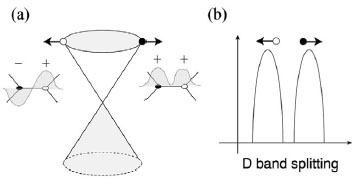Optical Science Laboratory, *Materials Science Laboratory
Graphene has several notable properties not seen in the conventional semiconductor.
For example, there is a degree of freedom known as pseudospin. It is a
general idea regarding the superposition of bonding and antibonding orbitals.
Normally bonding orbital is more stable than antibonding orbital in energy,
however, graphene is a special material in which bonding and antibonding
orbitals are degenerate. As a result, various types of superposition are
realizing at an energy contour surface. The direction of pseudospin is
defined by the superposition of bonding and antibonding orbitals in the
same manner as the direction of spin is determined by the superposition
of up and down spins. We are pursuing the possibility of pseudospintronics
of graphene.
As it is the first stage of spintronics to distinguish between up and
down spins, it is an important stage of pseudospintronics to distinguish
between up and down pseudospins. While spin direction is changed by a magnetic
field, pseudospin direction is changed by a stress. In material, there
exists an internal strain called phonon, and the pseudospin direction is
governed by the interaction between electron and phonon. Raman spectroscopy
is suitable for investigating the pseudospin. Here, we report on our study,
in which the two pseudospins that correspond to bonding and antibonding
orbitals are automatically selected in the Raman spectroscopy for graphene
edge.
In the Raman spectrum taken at a graphene edge, it is commonly observed
that the D band appears as a prominent peak [1]. A notable feature of the
D band is that there is a strong dependence on the polarization of light:
when the polarization is parallel to the edge, the intensity is the maximum,
and it is suppressed for perpendicular polarization. We clarified that
this polarization dependence originates from the pseudospin dependence
of electron-phonon interaction. Namely, because the D band is a special
(strain) phonon mode that consists only of the bond stretching motion,
the bonding and antibonding orbitals couple selectively to the D band [2].
This means that exciting the D band at graphene edge is the same as selecting
the up and down pseudospins (bonding and antibonding orbitals) among all
directions of pseudospins [Fig. 1(a)].
In addition, we predict that the D band splits into two peaks [Fig. 1(b)].
The higher (lower) frequency peak originates from up (down) pseudospin.
By this splitting, it is possible to distinguish between up and down pseudospins.
Although there is no report on the splitting of the D band at graphene
edge yet, the splitting of the D band has been observed in defective carbon
nanotubes [3].
[1] C. Cashiragi et al., Nano Lett. 9 (2009) 1433.
[2] K. Sasaki et al., Phys. Rev. B 85 (2012) 075437.
[3] S. Suzuki and H. Hibino, Carbon 49 (2011) 2264.
 |
||
|